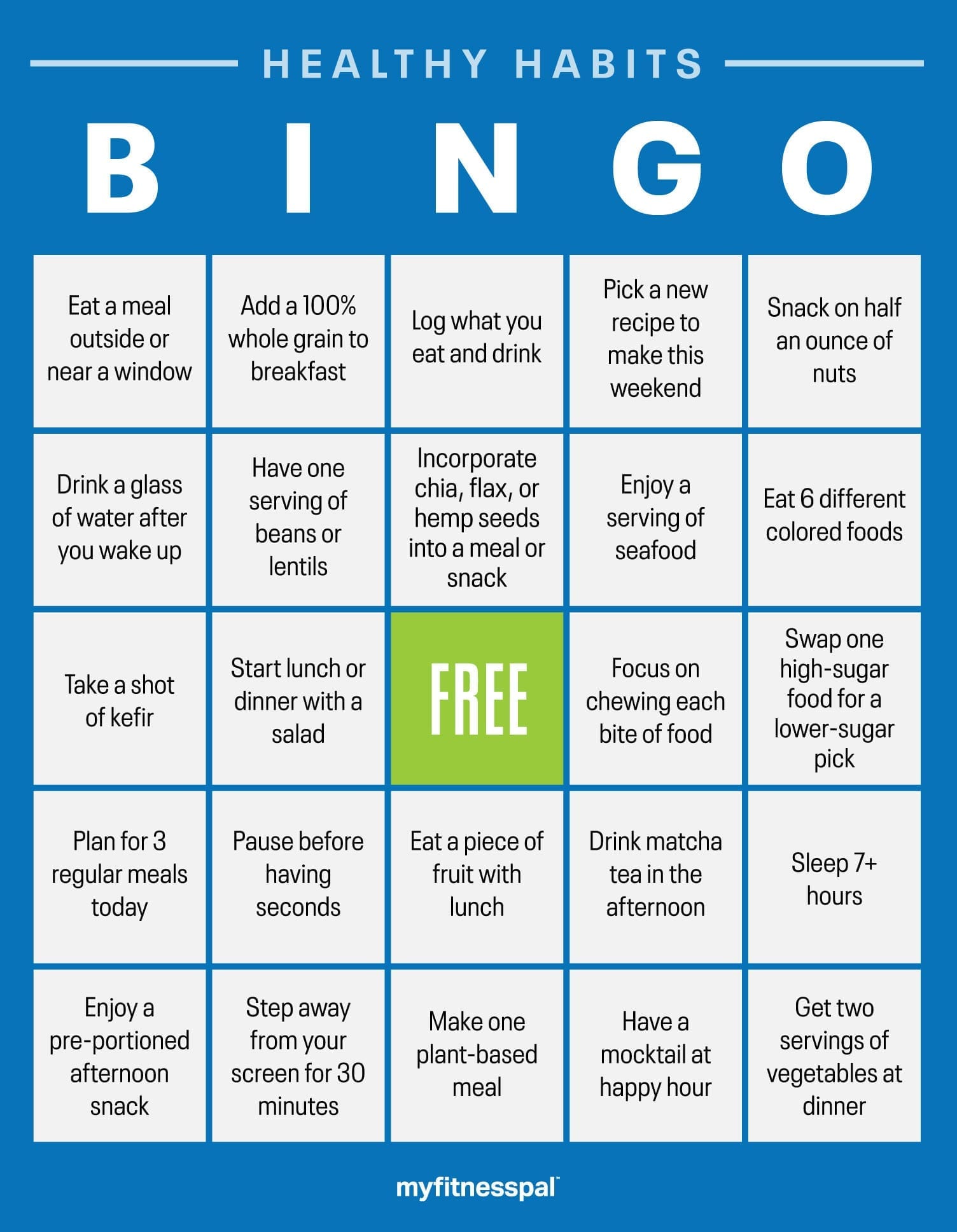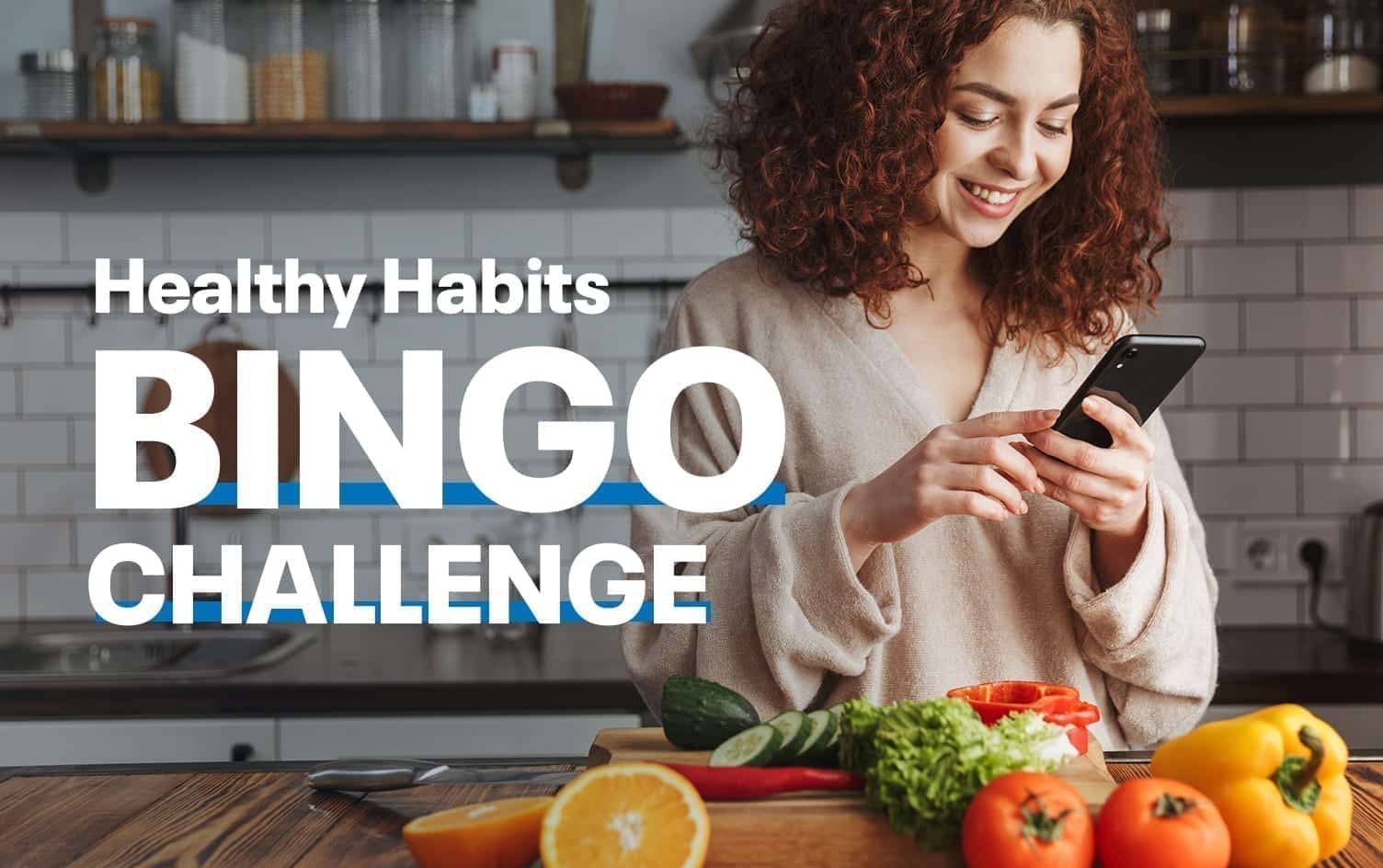
Science shows small, simple habits make a huge difference when it comes to losing weight and keeping it off. This take on the classic game provides inspiration for creating healthy habits you can maintain long-term and adds some fun along the way. You don’t need to get BINGO in a day, but start with the square that’s most appealing to you and use it as a stepping stone to improve your nutrition habits. Challenge yourself, friends and family to see who can get five squares in a row and yell BINGO!
EAT A MEAL OUTSIDE OR NEAR A WINDOW
“Light exposure will give you a dose of immune-boosting vitamin D,” says Dawn Jackson Blatner, RD. Besides, “most people are rushing through a meal while working on a computer. This helps you slow down for more satisfaction,” she says.
ADD A 100% WHOLE GRAIN TO BREAKFAST
“Whole grains are packed with fiber, an important nutrient the average person is not consuming enough of each day,” says Keri Gans, RD. Increasing your fiber intake supports weight loss and breakfast is a great place to start to get the recommended 25 grams for women and 38 grams for men. Opt for oatmeal, whole-grain toast or high-fiber, low-sugar cereal.
LOG WHAT YOU EAT AND DRINK
Research shows keeping a food diary is one of the most successful tools to lose weight. Consistently logging what you eat and drink helps you recognize trends and make smarter food choices. Use an app like MyFitnessPal, which makes logging even easier and faster with innovative technology like Meal Scan.
PICK A NEW RECIPE TO MAKE THIS WEEKEND
Get out of a food rut by choosing one new recipe to make this weekend, suggests Jackson Blatner. If you need some inspiration, check out MyFitnessPal’s recipe discovery, which features hundreds of healthy recipes — from high protein to low carb — you can log directly in the app.
Bonus points for choosing a food or ingredient you haven’t had in a while. “Eating a variety of foods gives your body an array of nutrients,” she says.
SNACK ON 12 ALMONDS
Eating a half-serving of nuts (in this case, it’s about 12 almonds, but choose whatever nut you fancy), is associated with a lower risk of obesity, especially if the nuts are subbed for less-healthy foods like potato chips, research shows.
DRINK A GLASS OF WATER WHEN YOU WAKE UP
“Staying hydrated is one of the best things you can do for your body,” says Gans. It helps you avoid mistaking thirst for hunger, key for preventing overeating. Starting your morning with a tall glass of water also helps you feel fuller at breakfast.
HAVE ONE SERVING OF BEANS OR LENTILS
These fall under the category of “pulses,” which are associated with better blood lipids, blood pressure, reduced inflammation, and a healthier weight, concludes a review in Critical Reviews in Food Science and Nutrition. Beans and lentils are also a great source of plant-based protein and are budget-friendly.
INCORPORATE CHIA, FLAX OR HEMP SEEDS INTO A MEAL OR SNACK
“Seeds are a triple threat because they provide healthy fats, fiber and protein,” says Jackson Blatner. Sprinkle one (or all three) on oatmeal, smoothies or salads.
ENJOY A SERVING OF SEAFOOD
Consuming fish or shellfish two times per week gives you important omega-3 fatty acids, which support brain and heart health. Gans suggests purchasing Alaskan seafood: “It’s wild and sustainable,” but you can also try these five fatty fish that are great for weight-loss.
EAT SIX DIFFERENT COLORED FOODS
“Color is an indicator of the phytonutrients, or plant compounds, in foods,” explains Jackson Blatner. For instance, red indicates lycopene (an antioxidant that fights inflammation) and orange is carotenoids (which support eye health). Today, get in red, orange, yellow, green, blue and purple. Have eggs with bell peppers and greens at breakfast, snack on carrots and hummus, toss purple onions into a grain bowl or salad and enjoy blueberries in a parfait for dessert.
TAKE A SHOT OF KEFIR
This drinkable form of yogurt contains more probiotics than yogurt. It’s pretty tangy, so a fun way to drink it is to take a shot (or a small glass) and then “chase” it with a few berries to improve the flavor. “Berries also have fiber, which feeds the good gut bacteria found in the kefir,” says Gans.
START LUNCH OR DINNER WITH A SALAD
“Just 1 cup of leafy greens is a serving of veggies,” says Gans. It can be easy to prepare, too. Pour out some bagged lettuce, add a couple of cherry tomatoes and drizzle with your favorite dressing. Not only is it low in calories, but you’ll get important micronutrients and feel satiated, meaning less likely to overeat.
SWAP A HIGH-SUGAR FOOD FOR A LOWER-SUGAR PICK
“Brainstorm one place where you eat something packed with sugar and then change it up,” says Gans. Maybe that’s ordering plain almond milk in your latte instead of sweetened almond milk or eating berries with Greek yogurt for dessert instead of pre-packaged cookies. These small swaps make cutting back on sugar easier to maintain while helping you reach your goals.
FOCUS ON CHEWING EACH BITE
“Chewing is the first step of digestion and resolves a lot of the bloating people experience,” says Jackson Blatner. Taking the time to enjoy your meals and snacks slowly, by focusing on chewing each bite, also helps you notice when you’re actually full. The result: You consume fewer calories than if you ate with distractions.
PLAN FOR THREE REGULAR MEALS
Skipping meals might help you cut calories, but it’s associated with poorer diet quality, something that can have an effect on your health in the long-run, notes a 2020 study in Public Health Nutrition. What’s more, waiting too long to eat between meals can backfire, leading you to consume whatever’s around and reach for high-calorie foods.
PAUSE BEFORE HAVING SECONDS
There’s nothing wrong with going for seconds, but take one beat to check in with yourself — are you still hungry or are you full? “This helps you determine your hunger and fullness cues for real,” says Jackson Blatner.
EAT A PIECE OF FRUIT WITH LUNCH
“Make this your post-lunch dessert,” says Gans. It’s great as a sweet treat to button up your meal and boost satisfaction — not to mention, it adds fiber and vitamins to your diet.
DRINK MATCHA TEA IN THE AFTERNOON
Instead of your usual coffee, have matcha tea in the afternoon. “Matcha contains L-theanine to deliver the energy and focus you’re looking for midday without the side effects like jitters or sleep disruption,” says Jackson Blatner. Bonus: Matcha is rich in disease-fighting antioxidants.
SLEEP 7+ HOURS
It might not be an eating habit directly, but the quality of your sleep influences how you eat the next day. Shorting sleep skews hunger hormones, so you’re more likely to eat when you’re not hungry and reach for sugary foods to put pep back in your step. Sleeping at least 7 hours, says Gans, helps you approach food in a more even headspace and helps mitigate the effects of stress (which can also trigger mindless eating).
EAT A PRE-PORTIONED AFTERNOON SNACK (IF YOU’RE HUNGRY)
Snack prep is just as important as meal prep for portion control and hitting your goals. Think string cheese, a single-serve bag of pistachios, or a little container of hummus. “Having a pre-portioned snack can prevent overeating in the middle of the day,” says Gans.
STEP AWAY FROM YOUR SCREEN FOR 30 MINUTES
While it may be a real challenge, it’s worth it. People who spend the most time in front of a screen (a computer, TV, phone) have the least healthy diets and are more likely to consume fast food compared to more moderate users, per research published in BMC Public Health. They’re also more likely to say their health is poor. Schedule at least 30 minutes a day to have a lunch break away from your computer. Bonus points if you go for a walk to combat sedentary behavior.
MAKE ONE PLANT-BASED MEAL
Switch one meat meal to a plant-based one, recommends Gans. “This cuts saturated fat intake, which is good for your heart,” she says. It’s also budget-friendly and a great way to help the environment.
HAVE A MOCKTAIL FOR HAPPY HOUR
Alcohol can hamper weight loss since it adds extra calories and impairs sleep. If you’re accustomed to ending your day with a boozy beverage, cut back on your intake by sipping a mocktail tonight.
GET TWO SERVINGS OF VEGETABLES AT DINNER
To hit a goal of 3–5 servings of veggies per day, doubling up at dinner adds volume and fiber to boot the fullness factor, says Gans.
Make progress every day while you work on mini fitness and nutrition goals, like walking more steps or learning to track macros. Go to “Plans” in the MyFitnessPal app for daily coaching and easy-to-follow tasks to keep you motivated.




